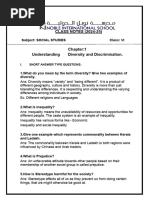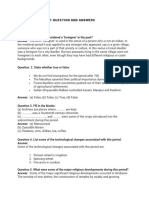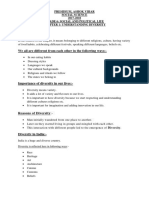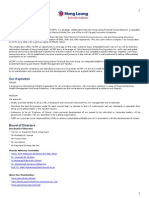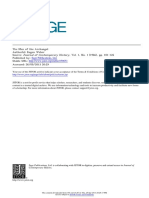0 ratings0% found this document useful (0 votes)
8 viewsUnderstanding Diversity Civics Chapter 1
Understanding Diversity Civics Chapter 1
Uploaded by
oggycartoon35Copyright:
© All Rights Reserved
Available Formats
Download as PDF, TXT or read online from Scribd
Understanding Diversity Civics Chapter 1
Understanding Diversity Civics Chapter 1
Uploaded by
oggycartoon350 ratings0% found this document useful (0 votes)
8 views6 pagesCopyright
© © All Rights Reserved
Available Formats
PDF, TXT or read online from Scribd
Share this document
Did you find this document useful?
Is this content inappropriate?
Copyright:
© All Rights Reserved
Available Formats
Download as PDF, TXT or read online from Scribd
Download as pdf or txt
0 ratings0% found this document useful (0 votes)
8 views6 pagesUnderstanding Diversity Civics Chapter 1
Understanding Diversity Civics Chapter 1
Uploaded by
oggycartoon35Copyright:
© All Rights Reserved
Available Formats
Download as PDF, TXT or read online from Scribd
Download as pdf or txt
You are on page 1of 6
Understanding Diversity Civics Chapter 1
NCERT Extra Questions for Class 6 They eat different types of
Social Science Civics Chapter 1 foods.
Understanding Diversity They celebrate differents
Understanding Diversity Class 6 festivals.
Extra Questions Very Short Answer They practise different
Type religions.
Question 1. Question 3.
Imagine if all the story-tellers and What are constant reminders of our
writers that you have heard and read rich traditions of respect for
so far were forced to live in a place diversity?
where all people wore the same two Answer:
colours red and white, ate the same Songs and symbols.
food (may be potatoes!), took care of Understanding Diversity Class 6
the same two animals, for example, Extra Questions Short Answer Type
the deer and the cat, and to entertain Question 1.
themselves played snakes and How are history and geography tied
ladders. What kind of stories do you in the cultural life of a region?
think they would write? Clarify with examples from Ladakh
Answer: and Kerala.
First on red and white colour Answer:
story. Kerala and Ladakh are different in
Second, potatoes and the men. terms of geographical features.
Cat and deer story. Geography of Kerala made
Snakes and the laddar (ludo). possible the cultivation of
spices and rice.
Its coastal location made
fishing possible.
Geography of Ladakh made
possible the wool collection as a
major occupation of the
Ladakhi people.
History of both the regions has seen
similar cultural influences.
Chinese and Arab Traders
Question 2.
came to these regions and set
How is India a country of diversities?
up trading occupations there.
Answer:
Question 2.
India is a land of diversities because
How is the influence of diverse
of the following:
cultures still in vogue?
People speak different
Answer:
languages.
Influence of diverse cultures is still Ultimately they uprooted the British
in vogue because of the following: Empire from India and attained
Man’s life is on the move at freedom in 1947.
present. Question 4.
We go from place to place and Perhaps you have not noticed that
adopt the culture of new places there are several people in the
where we live in. locality where you live who are poor
Our cultural traditions also and who do not have enough to eat or
undergo a change. wear and sometimes not even a place
We also adopt several things to live. This difference is not the
from our neighbourhood. same as the one we have seen earlier.
Our daily life also changes This is not a difference but it is the
accordingly. question of inequality. How does
We also hear stories of other’s inequality come?
customs and traditions. Answer:
Question 3. Inequality comes when there is a big
How was unity in diversity seen gap between the haves and the have-
during the British rule in India? nots.
Answer: One has resources and opportunities
People of India have diverse in abundance while another does not
cultures, customs, traditions have them at all.
and backgrounds. One lives in luxurious houses
British took advantage of this while another does not have
diversity and ruled India for even a place or jhoogi to live in.
nearly 300 years. One spends extravagantly,
But the diverse people rose against another does not have enough
the British as one nation. They to meet his both ends.
showed unity in diversity and threw Caste system is another example of
their rule from India. inequality.
Man and woman from different Society has been divided into
cultures, customs, traditions different groups on the basis of
and backgrounds came together work done by the people.
to oppose the British. A potter’s son is a potter.
They took part in the freedom A person engaged in one work
struggle. could not think of another work
They went to jail together. done by others.
They worked together to decide This created inequality in the
joint actions. society.
They acted as one against the Question 5.
British. From where people who write stories
get their ideas?
Answer:
People who write stories get their People travelled from one place
ideas from all sorts of different places to another in ships, on horses,
such as on camels or on foot, before the
1. books advent of trains, aeroplanes,
2. real life buses or cars.
3. their imagination. They went to new lands to
People living in forests chose settle or to trade.
writing about their fight and They stayed for a long time at
friendships with animals. one place once they settled
Others wrote stories about love there.
and honour describing kings They left their homes due to
and queens. famines and droughts as they
Some people wrote their could not get enough food there.
childhood memories of school Some of them went in search of
and friends. work.
Question 6. When they settled in new
What does Jawahar Lai Nehru say in places they began to change
his book, ‘Discovery of India’ about their life-style according to new
unity in diversity? surroundings, smother time
Answer: they adopted old styles.
Jawahar Lai Nehru says that Due to mix of old and new, their
Indian unity is not imposed languages, food, music,
from outside. religions, also underwent
It was something deeper and change.
within its fold. Inter mixing of cultures
People practised the widest resulted in new and different
tolerance of beliefs, and styles, giving birth to
customs. diversities.
They acknowledged and Thus regions became very diverse
encouraged variety. because of their unique histories.
Unity in diversity exists in Geographical Basis:
India. People adapt their lives
Nehru described his country, according to geographical
“unity in diversity.” conditions.
Understanding Diversity Class 6 Life-style of the people living
Extra Questions Long Answer Type near sea is different from those
Question 1. living in mountainous areas.
How do we explain diversity? They are different in their
Answer: clothing, work, foods, living
We explain diversity in the following styles and in growing food and
manner: vegetables.
Historical Basis:
Question 2. – rice, fish and
Let us try to understand what we vegetables.
mean when we say that historical Many Arab
and geographical factors influence Traders came and
the diversity of a region. We can do settled in Kerala.
this by reading about life in two Ibn Battuta Muslim
different parts of the country, Kerala travelled 700 populations
and Ladakh. Now years ago. reached there 400
do this exercise. According to him years before.
Answer: Muslim
Kerala Ladach community was
Kerala is located respected.
Ladakh is a
in the South West St. Thomas is
desert in the Kamer Saga is
of India, bounded believed to come
mountain of sung by both
by sea on one side here and bring
J&ICs eastern Muslims and
and by mountains Christianity to
part. Budhhists.
on the other. India.
Spices – pepper, Land covered Different
cloves, with snow for a religions are
cardamoms are large part of the practised due to
on the hills. year. Kamer Saga is
historical
sung by both
Fertile land and background like
Sheep keeping: Muslims and and
abundant rainfall Judaism, Islam,
Pashmiiia shawl poems.
have resulted in Christianity,
is woven in
the rice Hinduism and
Kashmir.
cultivation. Buddhism.
Fishing is main Food – meat and Understanding Diversity Class 6
occupation due to milk (cheese and Extra Questions Multiple Choice
location on sea. butter). Questions
Caravan routes Choose the correct answer:
through passes to Question 1.
Cheenawala nets Tibet – trade in To which caste does Sameer Ek
are used. textiles, spices, belong?
raw silk and (a) Muslim
carpets (b) Hindu
Cheenashalli (c) Sikh
(utensils from Buddhism (d) None of these
China) are also reached Tibet via Answer:
popular for Ladakh. Hindu
frying. Major food Question 2.
Which language does Sameer Do
speak? Question 7.
(a) English Where are the Pushmina shawls
(b) Hindi woven?
(c) Sanskrit (a) In Kashmir
(d) Tamil (b) In Tamil Nadu
Answer: (c) In Mumbai
Hindi (d) In Haryana
Question 3. Answer:
What does Sameer Ek do? In Kashmir
(a) Goes to school Question 8.
(b) Sells the newspapers What is dzos?
(c) Both (a) and (b) (a) A type of yak-cow
(d) None of these (b) A type of dog
Answer: (c) A type of goat
Sells the newspapers (d) A type of cat
Question 4. Answer:
Which caste does Sameer Do belong A type of yak-cow
to? Question 9.
(a) Hindu Name the religion which reached
(b) Muslim Tibet via Ladakh?
(c) Sikh (a) Jainism
(d) Christian (b) Buddhism
Answer: (c) Islam
Muslim (d) Sikhs
Question 5. Answer:
On which source do the people of Buddhism
Ladakh depend for drinking water? Question 10.
(a) Rivers Name the state located in Southwest
(b) Sea corner of India,
(c) Melting of snow (a) Kashmir
(d) None of these (b) Haryana
Answer: (c) Kerala
Melting of snow (d) All of these
Question 6. Answer:
Which region/state produces the Kerala
Pushmina wool? Question 11.
(a) Ladakh Who wrote the travelogue in which
(b) Jamshedpur the writer described the lives of
(c) Kolkata Muslims’?
(d) Delhi (a) Jawaharlal Nehru
Answer: (b) Lai Bahadur Shastri
Ladakh (c) Ibn. Battuta
(d) Indira Gandhi (a) helping them
Answer: (b) opposing them
Ibn. Battuta (c) both (a) and (b)
Question 12. (d) none of these
The utensils used for frying Answer:
cheenavala are called opposing them
(a) fry-pan Question 17.
(b) cheenachatti In which city of India is Jallianwalla
(c) both (a) and (b) Bagh situated?
(d) none of these (a) Amritsar
Answer: (b) Kurukshetra
cheenachatti (c) Panipat
Question 13. (d) Mumbai
In what manner are Kerala and Answer:
Ladakh quite different? Amritsar
(a) Geographical features Question 18.
(b) Biological features Who wrote the Discovery of India?
(c) Historical features (a) Pt. Jawaharlal Nehru
(d) All of these (b) Indira Gandhi
Answer: (c) Atal Bihari Vajpayee
Geographical features (d) Lal bahadur shastri
Question 14. Answer:
Which is the major product grown in Pt. Jawaharlal Nehru
Kerala? Question 19.
(a) Wool Who coined the phrase ‘Unity in
(b) Spices like clove diversity’ to describe the country?
(c) Both (a) and (b) (a) Pt. Jawaharlal Nehru
(d) None of these (b) Mahatma Gandhi
Answer: (c) Indira Gandhi
Spices like clove (d) Rajeev Gandhi
Question 15. Answer:
Which is the product of Ladakh? Pt. Jawaharlal Nehru
(a) Spices Question 20.
(b)Wool Who composed our National
(c) Cotton Anthem?
(d) All of these (a) Pt. Jawaharlal Nehru
Answer: (b) Lai Bahadur Shastri
Wool (c) Rabindranath Tagore
Question 16. (d) Atal Bihari Vajpayee
While the British ruled India, women Answer:
and men from different regions, Rabindranath Tagore
cultural faith came together for
You might also like
- Glossary: SPL Ch1: Understanding Diversity Notebook AssignmentDocument3 pagesGlossary: SPL Ch1: Understanding Diversity Notebook AssignmentsiddhantNo ratings yet
- Class 6 Civics NotesDocument21 pagesClass 6 Civics Notesbadge21.20100% (1)
- Civics Chapter 1Document4 pagesCivics Chapter 1umang6c2010No ratings yet
- political science (1)Document2 pagespolitical science (1)KalyanNo ratings yet
- ch1 civicsDocument4 pagesch1 civicsNeha GargNo ratings yet
- 270424105912File6TH SOCIAL SCIENCE FA-1Document12 pages270424105912File6TH SOCIAL SCIENCE FA-1famkmr11No ratings yet
- 21148c19-b276-40cf-8277-3395bae2ea1fDocument2 pages21148c19-b276-40cf-8277-3395bae2ea1fbtsarmypabhNo ratings yet
- CBSE Notes Class 6 Civics Chapter 1-Understanding DiversityDocument3 pagesCBSE Notes Class 6 Civics Chapter 1-Understanding Diversitydhivya sankarNo ratings yet
- Class - 6 Subject - Social Studies (Civics) Chapter - 20 UNDERSTANDING DiversityDocument4 pagesClass - 6 Subject - Social Studies (Civics) Chapter - 20 UNDERSTANDING Diversitydpsr mathsNo ratings yet
- G6 SPL CH 1 Q-AnsDocument3 pagesG6 SPL CH 1 Q-AnsDr. Amit JainNo ratings yet
- Civics CH 1Document7 pagesCivics CH 1manasmanojNo ratings yet
- Understanding DiversityDocument4 pagesUnderstanding DiversitypinkypinkyponkyNo ratings yet
- WorksheeeeeeeeetDocument3 pagesWorksheeeeeeeeetrfmngmyxb7No ratings yet
- Religion, Language, RitualsDocument11 pagesReligion, Language, RitualsNeha GargNo ratings yet
- Worksheet Prelim 1Document8 pagesWorksheet Prelim 1Manilyn Blanco Dela Cruz100% (1)
- Civics Q n ADocument17 pagesCivics Q n ARajeshNo ratings yet
- Chemistry Class Vi Session 2020-21Document48 pagesChemistry Class Vi Session 2020-21rogo2577No ratings yet
- unity in diversityDocument9 pagesunity in diversitymeshaNo ratings yet
- Understanding DiversityDocument2 pagesUnderstanding DiversitySurjeet SinghNo ratings yet
- Tribal Communities in IndiaDocument11 pagesTribal Communities in IndiaBond__001No ratings yet
- Civics Exercise 6 New-1Document29 pagesCivics Exercise 6 New-1Barnali Saha100% (1)
- CHAPTER 1 CLASS 6TH POLITYDocument10 pagesCHAPTER 1 CLASS 6TH POLITYAkash SharmaNo ratings yet
- History Chapter 1 Question and AnswersDocument3 pagesHistory Chapter 1 Question and AnswersMr MisterNo ratings yet
- History 1Document12 pagesHistory 1meenusharma2792No ratings yet
- Civics Class-6 L-1Document3 pagesCivics Class-6 L-1RamakantaSahooNo ratings yet
- Chapter 1 Understanding DiversityDocument12 pagesChapter 1 Understanding DiversityRajeshNo ratings yet
- Hanaa History Chapter 1 NoteDocument14 pagesHanaa History Chapter 1 NotecndhnewNo ratings yet
- 3RD Grade Social Studies 31 - SS - 3 - Unit - 02 - GuideDocument5 pages3RD Grade Social Studies 31 - SS - 3 - Unit - 02 - GuideBenie BudNo ratings yet
- UCSP Module 4 Lecture NotesDocument6 pagesUCSP Module 4 Lecture NotescobalthansNo ratings yet
- Fees 108Document12 pagesFees 108saranangare029No ratings yet
- Tracing Changes Through A Thousand ChangesDocument3 pagesTracing Changes Through A Thousand Changesshashwatkumarjha22No ratings yet
- Indigenous Worldwide ViewDocument28 pagesIndigenous Worldwide Viewkawaii velascoNo ratings yet
- Chapter-1 Understanding DiversityDocument13 pagesChapter-1 Understanding DiversitySatish BhadaniNo ratings yet
- 1656585711Document3 pages1656585711Aamir FatahyabNo ratings yet
- An Introduction To North American Indian CulturesDocument3 pagesAn Introduction To North American Indian CulturesNicolle DonayreNo ratings yet
- Ucsp Quarter 1 Module 4Document7 pagesUcsp Quarter 1 Module 4armorgames2112No ratings yet
- Understanding Culture, Society, and Politics: Sir Devin Pascua SubiaDocument44 pagesUnderstanding Culture, Society, and Politics: Sir Devin Pascua SubiaDevin SubiaNo ratings yet
- Lesson Cultural Diversity Positive ConceptDocument6 pagesLesson Cultural Diversity Positive ConceptmaidaNo ratings yet
- NCERT Solutions For Class 7 History Social Science Chapter 1 Tracing Changes Through A Thousand YearsDocument4 pagesNCERT Solutions For Class 7 History Social Science Chapter 1 Tracing Changes Through A Thousand YearsmeghtNo ratings yet
- CULTUREDocument6 pagesCULTUREMuôn Nguyễn PhươngNo ratings yet
- Long TestDocument12 pagesLong TestJovi ParaniNo ratings yet
- Class 7 History NCERT Solution Chapter 1 Introduction Tracing Changes Through A Thousand YearsDocument31 pagesClass 7 History NCERT Solution Chapter 1 Introduction Tracing Changes Through A Thousand YearsArtham ResourcesNo ratings yet
- Class 6th - CIVICS Complete Chapter ExplanationDocument182 pagesClass 6th - CIVICS Complete Chapter Explanationmadhavt592No ratings yet
- G6 CH1 Understanding DiversityDocument4 pagesG6 CH1 Understanding DiversityTanvika AroraNo ratings yet
- Understanding Diversity Class 6 Notes Social Science Civics Chapter 1-Converted1Document2 pagesUnderstanding Diversity Class 6 Notes Social Science Civics Chapter 1-Converted1SampathkumarNo ratings yet
- Grade 6 SST Notes P-A 1Document4 pagesGrade 6 SST Notes P-A 1kamlesh_khamitkarNo ratings yet
- 1 History Tracing ChangesDocument30 pages1 History Tracing Changeshellohimynameis8igNo ratings yet
- 6th 1Document18 pages6th 1rohit kohliNo ratings yet
- Chapter 1 Very Short Answer QuestionsDocument20 pagesChapter 1 Very Short Answer QuestionsRajeshNo ratings yet
- aQNfU1H6l5k4t86G9uFU PDFDocument5 pagesaQNfU1H6l5k4t86G9uFU PDFAsadevNo ratings yet
- Study Guide: American Indian Dance With Eddie MadrilDocument26 pagesStudy Guide: American Indian Dance With Eddie MadrilmontalvoartsNo ratings yet
- 11 TVL Ict Ucsp Module 1.3 Answer SheetDocument7 pages11 TVL Ict Ucsp Module 1.3 Answer SheetEric John Sañido ValenzuelaNo ratings yet
- grade_6th____notes_what_where_how_and_when (5)Document3 pagesgrade_6th____notes_what_where_how_and_when (5)Aaban khanNo ratings yet
- Class 6th Civics Chapter 1Document4 pagesClass 6th Civics Chapter 1Katha SagarNo ratings yet
- Angie Ucsp Grade 12 w3Document6 pagesAngie Ucsp Grade 12 w3Princess Mejarito MahilomNo ratings yet
- Angie Ucsp Grade 12 w3Document6 pagesAngie Ucsp Grade 12 w3Princess Mejarito MahilomNo ratings yet
- SHS Humss Ucsp Q1 WK4Document6 pagesSHS Humss Ucsp Q1 WK4Edelweiss 27100% (1)
- Inquiry ProjectDocument18 pagesInquiry ProjectbrodysewellNo ratings yet
- UNIT-1 NewDocument29 pagesUNIT-1 NewAbdul rahmanNo ratings yet
- Land and Social Change in East Nepal: A Study of Hindu-Tribal RelationsFrom EverandLand and Social Change in East Nepal: A Study of Hindu-Tribal RelationsNo ratings yet
- Bureaucratic Management: Max Weber Scientific Management WeberDocument6 pagesBureaucratic Management: Max Weber Scientific Management WeberGolie NyirendaNo ratings yet
- KênhDocument8 pagesKênhQuan LyNo ratings yet
- 3HAC022327-002 Rev00Document31 pages3HAC022327-002 Rev00TensaigaNo ratings yet
- The Flaming Star of Set - UnlockedDocument7 pagesThe Flaming Star of Set - UnlockedChisomOji100% (1)
- COC Maryborough Newsletter 18 Oct 2009Document2 pagesCOC Maryborough Newsletter 18 Oct 2009Andrew StorrsNo ratings yet
- Emergence of Old Age HomesDocument4 pagesEmergence of Old Age HomesRachel100% (1)
- Bob Bly VSL TipsDocument1 pageBob Bly VSL TipsjoeyNo ratings yet
- Corporate Profile HLTMTDocument12 pagesCorporate Profile HLTMTAzihan AripinNo ratings yet
- Coolant Loss - External: Symptom Tree t020Document2 pagesCoolant Loss - External: Symptom Tree t020Mohamed ZakiNo ratings yet
- Love of CountryDocument85 pagesLove of CountryBagsik AlabNo ratings yet
- Wedding Photography TipsDocument3 pagesWedding Photography Tipsnathanwrites7280No ratings yet
- Toledo Vs CADocument18 pagesToledo Vs CARodney AtibulaNo ratings yet
- ENGLISH-5 DLL Q3 Week-2Document6 pagesENGLISH-5 DLL Q3 Week-2Liezl Joy Eslao DudangNo ratings yet
- Which Is The Famous Sweet of Agra?Document19 pagesWhich Is The Famous Sweet of Agra?Lokesh MaharNo ratings yet
- ITC-Business StrategyDocument47 pagesITC-Business StrategyAsad khan67% (6)
- ICSE Board Class X Geography Board Paper - 2014: Time: 2 Hrs Total Marks: 80 General InstructionsDocument6 pagesICSE Board Class X Geography Board Paper - 2014: Time: 2 Hrs Total Marks: 80 General InstructionsAmanNo ratings yet
- NMG Catalog 9AKK2017109096 RevD EN 10-2024 LowresDocument20 pagesNMG Catalog 9AKK2017109096 RevD EN 10-2024 LowresBolesław ŁysyNo ratings yet
- PetitionDocument41 pagesPetitionAkbar JiwaniNo ratings yet
- Visual Basic For Applications - Wikipedia, The Free EncyclopediaDocument3 pagesVisual Basic For Applications - Wikipedia, The Free Encyclopediabeta2009No ratings yet
- PreeclampsiaDocument9 pagesPreeclampsiaBhawna Sharma67% (3)
- Part 1 Mechanics (Introduction)Document37 pagesPart 1 Mechanics (Introduction)Lancel AlcantaraNo ratings yet
- Project Operational ManagementDocument21 pagesProject Operational ManagementZafar AliNo ratings yet
- Kings - ACS-NYC v. Marisela Marrero, Nathaniel Graham - 5.11.23Document42 pagesKings - ACS-NYC v. Marisela Marrero, Nathaniel Graham - 5.11.23fnjeri451No ratings yet
- Weber, Eugen. "The Men of The Archangel." Journal of Contemporary History, Vol. 1, No. 1, 1966, Pp. 101-126. JSTOR,. Accessed 8 May 2021.Document27 pagesWeber, Eugen. "The Men of The Archangel." Journal of Contemporary History, Vol. 1, No. 1, 1966, Pp. 101-126. JSTOR,. Accessed 8 May 2021.Daniel CucuNo ratings yet
- Mid-Year Intercessory Prayer PointsDocument2 pagesMid-Year Intercessory Prayer PointskayeroNo ratings yet
- STSE AssignmentDocument3 pagesSTSE AssignmentpaulineNo ratings yet
- Example Formal ObservationDocument1 pageExample Formal Observationapi-288394442No ratings yet
- Topic 1Document38 pagesTopic 1perfect yueNo ratings yet
- General Lim Elementary School: Department of EducationDocument2 pagesGeneral Lim Elementary School: Department of EducationMhillette Y AlderightNo ratings yet
- Estudio de Las Propiedades Mecánicas Del Concreto Reforzado Con Fibras de Bagazo de Caña de AzúcarDocument11 pagesEstudio de Las Propiedades Mecánicas Del Concreto Reforzado Con Fibras de Bagazo de Caña de AzúcarYsaacMattosCamposNo ratings yet












